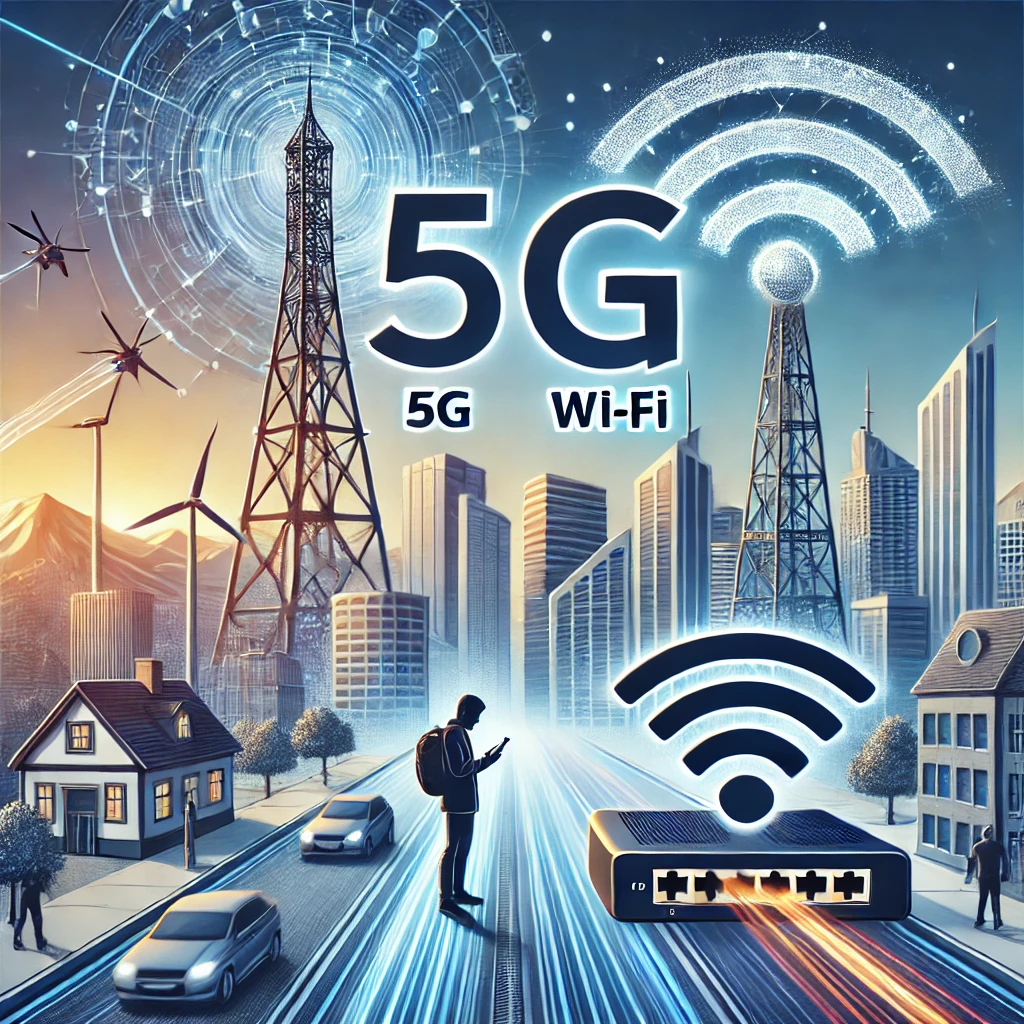5G vs. Wi-Fi: Which is best when you travel?

Staying connected while traveling is essential, whether for navigation, communication, or entertainment. Travelers often rely on two primary types of internet connectivity: 5G mobile networks and Wi-Fi. But which one is the better choice when you’re on the move?
In this guide, we’ll compare 5G vs. Wi-Fi for travelers, examining speed, availability, security, cost, and reliability to help you choose the best option for your next trip.
Understanding the Basics of 5G and Wi-Fi
What Is 5G Technology?
5G, short for fifth-generation cellular technology, is the latest leap in mobile network innovation. It builds on the foundation of 4G LTE but brings faster speeds, lower latency, and increased capacity. This means you can download files, stream videos, or even play online games with a level of speed and reliability that was previously unheard of. Unlike older networks, 5G uses higher frequency bands, which allow for quicker data transfer but often require more infrastructure, like small cell towers, to ensure coverage. It’s not just about speed, though. 5G also supports new technologies like IoT (Internet of Things) devices and augmented reality applications, making it more versatile than ever before.
What Is Wi-Fi and How Does It Work?
Wi-Fi is a wireless networking technology that connects devices to the internet within a limited range, usually through a router. Unlike 5G, which is managed by telecom providers, Wi-Fi operates on unlicensed frequency bands, meaning anyone can set up a network. It’s great for homes, offices, and public spaces because it allows multiple devices to connect simultaneously without using cellular data. Modern Wi-Fi standards, like Wi-Fi 6, have improved speeds, reduced latency, and better support for multiple connected devices. However, Wi-Fi is generally limited by its range and the quality of the router or access point.
Key Differences Between 5G and Wi-Fi
While both 5G and Wi-Fi aim to provide fast and reliable internet, they do so in different ways and are suited for different scenarios. Here are some key distinctions:
- Technology Type: 5G is a cellular network technology, while Wi-Fi is a local area network (LAN) technology.
- Coverage: 5G can cover large geographic areas, whereas Wi-Fi is typically confined to smaller spaces like homes or offices.
- Licensing: 5G operates on licensed and unlicensed spectrum bands, while Wi-Fi only uses unlicensed bands.
- Cost: Using 5G often involves data plans and potential roaming charges, while Wi-Fi is usually free or comes as part of an internet subscription.
- Use Cases: 5G is ideal for mobile connectivity and emerging tech like autonomous vehicles, while Wi-Fi excels in fixed locations like homes and businesses.
Understanding these differences can help you decide which option—or combination of both—is best for your travel needs.
Speed and Performance: 5G Versus Wi-Fi
How Fast Is 5G Compared to Wi-Fi?
When it comes to speed, both 5G and Wi-Fi can deliver impressive performance, but they shine in different scenarios. 5G networks, particularly in ideal conditions, can reach speeds of up to 20 Gbps. This makes 5G an excellent choice for activities requiring quick downloads or uploads, such as video conferencing or sharing large files while on the move. On the other hand, Wi-Fi—especially the latest Wi-Fi 6 standard—can achieve speeds up to 9.6 Gbps in controlled environments. While Wi-Fi speeds are more than sufficient for most tasks, they often depend on the quality of the local network and the number of users connected. Comparing mobile data and Wi-Fi, 5G tends to outperform Wi-Fi in outdoor or mobile settings, while Wi-Fi dominates in indoor environments with strong routers.
Latency and Responsiveness in Real-World Scenarios
Latency, or the time it takes for data to travel between two points, is another area where 5G has the upper hand. 5G offers ultra-low latency, often below 10 milliseconds, making it ideal for real-time applications like gaming, live streaming, or even remote surgeries. Wi-Fi, while generally reliable, can experience higher latency due to interference from other devices or networks. For travelers, this means 5G is better suited for tasks that demand immediate responsiveness, such as using augmented reality apps or navigating unfamiliar cities with GPS.
Bandwidth Capabilities of 5G and Wi-Fi
Bandwidth determines how much data can be transmitted simultaneously, and both 5G and Wi-Fi have their strengths. 5G networks are designed to handle a massive number of devices at once, which is why they are often used in crowded areas like stadiums or city centers. Wi-Fi, while capable, can struggle in high-density environments where multiple devices compete for the same signal. For travelers, this could mean smoother streaming or video calls on 5G in busy locations. However, in a hotel room or café with a well-maintained Wi-Fi network, you might not notice much of a difference. Ultimately, the choice between 5G and Wi-Fi often boils down to where you are and what you need to do.
Coverage and Range: Which Is Better for Travelers?
5G Coverage in Urban and Rural Areas
5G networks are expanding rapidly, but their availability still depends heavily on location. In urban areas, 5G signals are widely accessible due to the dense placement of cell towers. This means you can enjoy faster speeds and more reliable connections in cities. But in rural areas, the picture changes. 5G coverage becomes spotty because fewer cell towers are spread across larger distances. This can make it harder to rely on 5G when you’re traveling through remote locations or countryside areas.
The type of 5G also matters. Mid-band and high-band 5G offer faster speeds but shorter ranges, while low-band 5G provides broader coverage at the cost of speed. So, if you’re planning a trip, it’s smart to check the 5G coverage map for your destination.
Wi-Fi Accessibility in Public Spaces
Wi-Fi, on the other hand, is everywhere—airports, cafes, hotels, and even public parks. It’s usually free or comes at a low cost, making it a go-to option for many travelers. However, the quality of public Wi-Fi can be hit or miss. Speeds may slow down during peak usage, and coverage often depends on how close you are to the router. For example, if the router is in the hotel lobby, your room on the top floor might have a weak signal.
Another thing to consider is how secure public Wi-Fi networks are. They’re convenient but can expose your data to risks, especially in busy places like airports. Using a travel eSIM plan, like the one offered by Voye Global, can be a safer alternative for staying connected without relying on public networks.
Comparing Signal Strength and Range
When it comes to signal strength and range, both 5G and Wi-Fi have their strengths and weaknesses. 5G generally provides a stronger signal over longer distances compared to traditional Wi-Fi. This makes it a better choice for outdoor activities or when you’re on the move. However, Wi-Fi can offer better performance indoors, especially when placed strategically. For instance, 2.4 GHz Wi-Fi signals travel farther and penetrate walls better than 5 GHz signals, though they’re slower.
For travelers, the choice often comes down to what’s available and what you need. If you’re staying in a single location like a hotel or café, Wi-Fi might be more practical. But if you’re exploring a city or hiking in a remote area, 5G could be your best bet for staying connected.
Security Features of 5G and Wi-Fi
How Secure Is 5G?
5G networks bring a lot to the table when it comes to security. First off, 5G uses SIM-based authentication, which means your phone or device is identified through a SIM card or eSIM. This makes it harder for someone to hack into the network compared to systems that rely on passwords or usernames. Plus, 5G has built-in encryption that protects the data being sent and received. It also introduces features like subscription concealed identifiers (SUCI) that mask your device’s identity, adding an extra layer of privacy. But, because 5G connects so many devices, like smart cars and IoT gadgets, it also opens up more potential entry points for hackers. So, while it’s secure, it’s not invincible.
Wi-Fi Security Protocols Explained
Wi-Fi security has come a long way, especially with the introduction of Wi-Fi 6 and WPA3 (Wi-Fi Protected Access 3). WPA3 makes it tougher for hackers to break into networks by using stronger encryption and better authentication methods. For example, it supports 256-bit AES encryption, which is a big upgrade from older standards. Wi-Fi networks also often require passwords to join, which adds a basic level of security. But, there’s a catch: public Wi-Fi spots, like those at airports or coffee shops, can still be risky. Hackers can set up fake networks to trick you into connecting, so it’s always smart to double-check before logging on.
Privacy Concerns for Travelers
For travelers, privacy can get tricky with both 5G and Wi-Fi. With 5G, your data is generally encrypted, but your location might still be tracked by your carrier or even third parties. On the other hand, public Wi-Fi networks are notorious for being easy targets for cybercriminals. They can intercept your data, like passwords or credit card numbers, if the network isn’t secure. To stay safe, you might want to use a VPN (Virtual Private Network) when connecting to public Wi-Fi. It adds an extra layer of encryption, keeping your data private even on less secure networks.
Cost Considerations for 5G and Wi-Fi

Initial Setup Costs for 5G and Wi-Fi
When it comes to getting started, Wi-Fi tends to be the more budget-friendly option. Wi-Fi routers and access points are relatively inexpensive, and you don’t need a subscription to a carrier to use them. Plus, Wi-Fi operates on unlicensed spectrum, so there are no licensing fees involved. On the other hand, 5G requires more advanced hardware, like 5G-enabled devices and sometimes even specific network infrastructure. These costs can add up, especially for businesses or individuals looking to set up private 5G networks.
Ongoing Expenses for Travelers
For travelers, ongoing costs can vary significantly between 5G and Wi-Fi. Using 5G often involves a data plan from a mobile carrier, and these plans can get pricey, especially if you’re roaming internationally. However, eSIM technology, like the kind offered by Voye Global, can help travelers save money by providing affordable and reliable data packages in multiple countries. Wi-Fi, on the other hand, is usually free or low-cost in public spaces like cafes, hotels, and airports, but you might have to pay for premium access in certain places or invest in portable Wi-Fi hotspots for consistent connectivity.
Affordability in Different Regions
The affordability of 5G and Wi-Fi can also depend on where you are. In countries with widespread 5G infrastructure, mobile data plans may be competitively priced. Conversely, in areas where 5G is still rolling out, costs might be higher due to limited availability. Wi-Fi, being more established globally, is often the go-to option in regions where 5G is not yet prevalent. However, the quality and speed of Wi-Fi can vary greatly depending on the location, so travelers might find themselves balancing cost with connectivity quality.
Your Journey, Our eSIM
Stay online abroad with instant activation.
Reliability and Consistency: 5G Versus Wi-Fi
Network Reliability in Remote Locations
When you’re traveling, especially to remote areas, staying connected is often a challenge. 5G has a clear advantage here because it uses multiple frequency bands to extend its range. The low-band spectrum can cover long distances, making it ideal for rural or less populated regions. Wi-Fi, on the other hand, is generally limited to specific locations like hotels, cafes, or airports, which can leave you stranded if you’re out exploring.
That said, not all 5G networks are created equal. In ultra-remote areas, even 5G might struggle unless there’s a nearby cell tower. For those moments, having both options—5G for mobile coverage and Wi-Fi for stationary use—can be a lifesaver.
Interference Issues with Wi-Fi
Wi-Fi networks often operate in shared, unlicensed frequency bands, which can lead to interference. For example, in a crowded airport or a busy coffee shop, multiple Wi-Fi networks might overlap, causing slower speeds or dropped connections. This can be frustrating if you’re trying to upload photos or join an important video call.
5G, however, operates on licensed bands, which are regulated to minimize interference. This makes it a more reliable choice in situations where consistency is crucial. If you’re a traveler who depends on uninterrupted connectivity—whether for work or leisure—5G might be the better option.
Seamless Connectivity with 5G
One of the standout features of 5G is its ability to provide seamless handoffs between cell towers. Imagine you’re on a train moving through different coverage zones. With 5G, your connection is managed centrally by the network, reducing the chances of dropped calls or interrupted data streams. Wi-Fi, in contrast, requires you to manually reconnect to new networks as you move, which can be a hassle.
For international travelers, this difference becomes even more noticeable. Services like Voye Global’s eSIM make it incredibly easy to stay connected across borders, leveraging 5G’s capabilities for uninterrupted service. Wi-Fi, while useful, often requires you to hunt for a reliable network, which isn’t always feasible when you’re on the go.
In summary, while both 5G and Wi-Fi have their strengths, 5G often outshines Wi-Fi in terms of reliability and consistency, especially for travelers who prioritize staying connected no matter where their adventures take them.
Use Cases for 5G and Wi-Fi While Traveling
Streaming and Entertainment on the Go
When you’re on the move, staying entertained can be a lifesaver. Whether it’s streaming your favorite shows or listening to music, 5G and Wi-Fi both have their perks. 5G offers incredible speeds, making it perfect for streaming high-quality videos without buffering, even in transit. On the other hand, Wi-Fi is often the go-to option in hotels or cafes, where you can connect without worrying about data limits. For frequent travelers, finding a balance between the two can be key to uninterrupted entertainment.
Navigating with Maps and GPS
Traveling to unfamiliar places means relying heavily on navigation apps. 5G excels here, offering fast, real-time updates that help you avoid traffic or find alternate routes quickly. It’s especially useful in areas where public Wi-Fi isn’t available or secure. However, Wi-Fi can still play a role when you’re planning your route indoors, like at an airport or train station, where free networks are common. Combining both technologies ensures you’re never lost, no matter where you are.
Staying Connected for Work
For remote workers or business travelers, staying connected is non-negotiable. Video calls, file uploads, and constant communication require a stable and fast connection. 5G is a game-changer for this, providing reliable internet even in crowded or remote locations. Wi-Fi, meanwhile, is often the preferred choice in coworking spaces or accommodations, where it’s typically included. Using a mix of 5G and Wi-Fi can help you stay productive without missing a beat.
5G and Wi-Fi for International Travelers

Roaming Charges and Data Plans
When you’re traveling internationally, managing connectivity costs can be tricky. Mobile carriers often charge steep roaming fees that can quickly add up. However, 5G networks are making strides in offering more affordable and flexible options. Many carriers now provide international data plans tailored for travelers, which can include unlimited 5G access in multiple countries. For those who want to avoid traditional roaming charges, eSIM technology is a game-changer. Services like Voye Global let you switch to a local network seamlessly, eliminating the need for a physical SIM card. This is one of the most convenient mobile internet options for travelers who prioritize staying connected without surprises on their bill.
Using eSIM Technology with 5G
eSIMs are a fantastic option for modern travelers. Unlike traditional SIM cards, an eSIM is embedded in your device and can be activated digitally. This means you can switch between carriers and data plans without needing to visit a store or swap out a card. For international trips, this is a huge advantage. You can activate a local 5G plan in seconds, ensuring you have high-speed internet as soon as you land. Plus, eSIMs often come with competitive pricing, making them one of the best internet options for international trips.
Finding Reliable Wi-Fi Abroad
While 5G has its advantages, Wi-Fi connectivity on the go is still a crucial part of travel. Public Wi-Fi is widely available in hotels, airports, cafes, and even on trains or buses in many countries. However, the quality and security of these networks can vary. If you’re relying on Wi-Fi for work or streaming, you might want to invest in a portable Wi-Fi hotspot. These devices create a personal, secure Wi-Fi network and can connect multiple devices at once. They’re especially useful for group travel. That said, if you’re traveling solo, a robust 5G connection might be more practical and cost-effective.
In summary, the choice between 5G and Wi-Fi often depends on your travel style. For solo travelers or those who need constant, high-speed access, the advantages of 5G for travel are clear. On the other hand, Wi-Fi remains a reliable and cost-effective option, especially in urban areas where public networks are plentiful. Balancing these two technologies can help you stay connected no matter where your adventures take you.
Future Trends in 5G and Wi-Fi Technology
Upcoming Innovations in 5G
5G technology is still evolving, and the future looks promising. One major trend is the rollout of standalone 5G networks, which will operate independently of older 4G infrastructure. This shift will unlock faster speeds, lower latency, and better support for advanced technologies like augmented reality (AR) and virtual reality (VR). Another exciting development is the integration of 5G with edge computing. By processing data closer to the source, this combination will enable real-time applications like autonomous vehicles and smart cities. Lastly, 5G is expected to play a key role in expanding global access to the Internet, especially in remote and underserved areas.
The Evolution of Wi-Fi Standards
Wi-Fi technology isn’t slowing down either. Wi-Fi 7, the next generation, promises even faster speeds, lower latency, and increased capacity. This will be particularly useful in crowded environments like airports and stadiums, where many devices compete for bandwidth. Another trend is the growing interoperability between Wi-Fi and 5G. Devices are increasingly designed to switch seamlessly between the two, ensuring consistent connectivity. Additionally, advancements in Wi-Fi security protocols aim to address growing concerns about privacy and data protection, making Wi-Fi a safer option for users.
How These Technologies Will Shape Travel
For travelers, the convergence of 5G and Wi-Fi will redefine connectivity. Imagine stepping off a plane and automatically switching to a high-speed 5G network without worrying about roaming charges. Services like Voye Global’s eSIM technology are already paving the way for this kind of seamless experience. In hotels and public spaces, Wi-Fi will continue to be a staple, but with enhanced capabilities like faster streaming and better support for IoT devices. As these technologies mature, they’ll make it easier for travelers to stay connected, whether they’re exploring remote destinations or navigating urban landscapes.
Conclusion
When it comes to choosing between 5G and Wi-Fi for travel, it really depends on your needs. If you’re looking for broad coverage and reliable connectivity on the go, 5G is a strong option, especially with eSIM technology making it easier than ever to stay connected. On the other hand, Wi-Fi is often more cost-effective and works well in places where you can access a stable network, like hotels or cafes. In many cases, a mix of both technologies might be the best solution, ensuring you’re covered no matter where your travels take you. Ultimately, the choice comes down to how you plan to use your devices and what kind of connection you need most.
Global Coverage, Local Rates
Experience hassle-free connectivity wherever you go.








